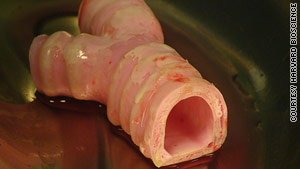2011年7月26日 星期二
2011年7月7日 星期四
Lab-made organ implanted for first time
 |
| This is the artificial trachea, covered in the patient's cells. |
Previous lab-generated transplants either used a segment of donor windpipe or involved tissue only, not an organ.
In a laboratory in London, scientists created a trachea, which is a tube-like airway that connects at the voice box and branches into both lungs.
On June 9, doctors implanted this synthetic windpipe into a 36-year-old man with late-stage tracheal cancer at Karolinska University Hospital in Stockholm. The patient is doing well and is expected to be released from the hospital Friday, said Dr. Paolo Macchiarini, professor of regenerative medicine there.
Tracheal cancers are extremely rare, accounting for less than 1% of all cancers.
After the patient's initial diagnosis in 2008, he had exhausted every treatment available, including chemotherapy, radiation and surgery, Macchiarini said. The patient, an Eritrean who had been studying in Iceland, is the subject of a BBC documentary airing Thursday in Sweden.
His tumor had almost blocked his windpipe, doctors said.
Rather than waiting for a transplant, his doctors suggested growing an organ. Scientists created a Y-shaped framework for the new trachea, modeling it after the specific shape of the patient's windpipe.
The form was made of polymers that had a spongy and flexible texture. Stiff rings around the tube mimicked the structure of a human trachea.
The form was then bathed in a solution containing the patient's stem cells "to get the cells to grow on the sponge material," said David Green, president of Harvard Bioscience. Stem cells can divide and turn into a range of cell types, including those in organs.
"Stem cells from the own patient were growing inside and outside," Macchiarini said. "This structure was becoming a living structure."
The stem cells were given physical or chemical cues to create the desired type, Green said.
Once the cells were thriving on the form, the artificial trachea was implanted into the patient.
His body accepted the new trachea, and he even had a cough reflex two days after the surgery, Macchiarini said.
Three years ago, Macchiarini made headlines by implanting an artificial trachea created from donor tissue combined with stem cells from the recipient, Claudia Castillo, whose windpipe had been damaged by tuberculosis.
"The results were quite good, but unfortunately we were still dependent" on organ donation, which can take months, Macchiarini said.
Creating the synthetic structure for the trachea in the current case took 10 to 12 days, compared with waiting months for an organ donor, Macchiarini said.
Earlier this year, regenerative medicine scientists at Wake Forest University School of Medicine reported that they had engineered five urethras between March 2004 and July 2007.
They had used a small piece of each patient's own tissue from the bladder, then grew the cells in a lab onto a mesh scaffold shaped like a urethra.
This area of research remains somewhat controversial in medicine, because critics say this could lead to human cloning.
But Macchiarini said making these first artificial organs viable in patients opens doors for future transplants through the relatively new field of regenerative medicine.
"It's a beautiful international collaboration," he said about the recent effort that involved doctors and researches in Sweden, the United Kingdom and the United States. "If scientists and clinicians work together, we can help humanity."
Source: CNN, 7th July 2011
2011年7月4日 星期一
Study gives hope to patients with genetic disease
Aussie study brings hope to a Templeton family
AMY CLASS
 |
| Anahera Inns, 4, with baby brother Tiaki aged 4 months. Blood from his umbilical cord may one day help Anahera'scystic fibrosis. |
Anahera has cystic fibrosis (CF), a genetic lung disease that cannot be cured.
However, a University of Melbourne faculty of medicine study aims to prove that stem-cell-rich umbilical cord blood can treat cystic fibrosis by regenerating lung cells.
Melbourne University medical genetics professor Bob Williamson said the project would eventually use
sibling's cord blood to treat children with cystic fibrosis (CF).
"Sibling cord blood has a one-in-four chance of being a perfect match that will not be rejected by the immune system of the child living with CF," he said.
Progress was slow, since it was essential to prove cells were safe to use in the lung, but the research was "positive", he said. However, a breakthrough on the research could be several years away.
New Zealand cord-blood stem-cell banking facility CordBank had since offered free sibling cord-blood banking to families who had a child with CF, he said.
"Because CordBank has come on board with the project, we are ensuring that affected families are banking precious sibling cord blood now, so they are ready when a breakthrough comes."
With the assistance of CordBank, the Inns family was able to collect the cord blood from Anahara's youngest brother, Tiaki, who was born in February.
The family were given free collection and storage for the next 18 years.
The blood is collected after a baby is born, before the mother's placenta is delivered. It must be transported to Auckland quickly for processing and storage.
So far, seven New Zealand families have taken up the CordBank offer.
Cystic Fibrosis Association of New Zealand chief executive Kate Russell said cystic fibrosis "is an expensive illness and families with a CF child can be placed under severe financial strain".
"People would be surprised at what the Government does not fund in terms of the most basic medical equipment and support for these families," she said.
Cecileah Inns said her daughter had "as normal a life as possible".
The toddler endured vigorous physiotherapy and was nebulised daily to help with lung drainage, she said.
"She's articulate and brave - a right little character. She doesn't know any different."
Anahera enjoyed being a "bossy" big sister to her brothers Mika, 3, and Tiaki, four months, neither of whom has cystic fibrosis.
Source: The Press, 4th July, 2011
訂閱:
文章 (Atom)
